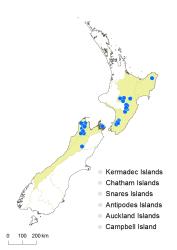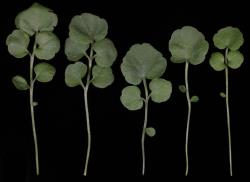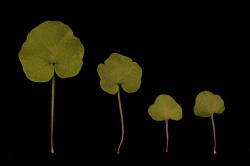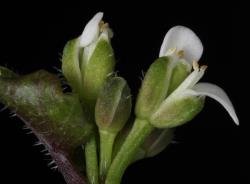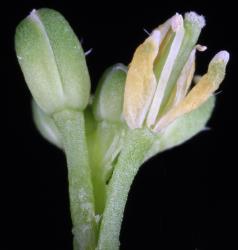Perennial herb, single rosette or several rosettes on short lateral branches, stem and branches 1.0–2.8 mm diam. Leaves up to 140 mm long, pinnatisect or simple; lamina 6.0–25.0 × 4.3–28.0 mm, green, membranous, glabrous or sparsely to moderately hairy on abaxial and adaxial surfaces, margin and petiole. Terminal pinna 4.7–36.0 × 5.5–33.0 mm, usually simple, with 4–10 shallow lobes each with a conspicuous hydathode, orbicular, orbicular-angular, apex obtuse with a conspicuous hydathode, base cordate or truncate and sometimes oblique. Lateral pinnae 1–2(–4), 1.9–15.0 × 2.1–12.5 mm, orbicular, orbicular-rhomboid, to broadly elliptic, base truncate or weakly cordate and sometimes oblique, petiolule 0.1–8.5 mm long; petiole up to 195 mm long; hairs 0.3–0.6 mm long. Cauline leaves with 0–4 lateral pinnae, otherwise similar to rosette leaves but smaller, often narrower, and with fewer but more distinctive lobes and hydathodes. Inflorescence raceme, each 4–8-flowered and sometimes with a solitary flower or lateral raceme lower down the peduncle; peduncle up to 350 mm long, 0.5–1.6 mm diam. at base, ascending, glabrous or occasionally sparsely hairy. Pedicels 4.5–44.0 mm long, 0.4–1.0 mm diam., glabrous. Sepals 2.4–3.0 × 1.1–1.6 mm, elliptic-oblong to broadly elliptic, ± saccate, green or red-brown, glabrous, margin white and membranous, apex obtuse, base truncate. Petals 7.5–9.0 × 2.5–5.0 mm, white, limb obovate to broadly elliptic; apex obtuse; base cuneate, tapering to a c. 1.0 mm-long claw. Stamens 6; median filaments 4, 2.8–4.0 mm long; lateral filaments 2, 1.8–3.1 mm long; anthers 0.5–0.7 mm long, cream to pale yellow and occasionally flushed maroon, when dehiscent held at a similar height to or slightly below the stigma. Ovary 3.1–4.8 mm long, 0.5–0.6 mm diam., ± terete, green, glabrous; ovules 14–18; style 0.3–0.4 mm long, ± terete; stigma c. 0.4 mm diam. Siliques 35.0–47.0 × 1.8–2.5 mm, glabrous, style 1.0–4.8 mm long; valves green at maturity; straw-coloured when dehiscent, replum 0.7–0.8 mm wide. Seeds 1.8–2.2 mm long, 1.1–1.5 mm wide, 0.5–0.6 mm thick, oblong, henna to henna-green; wing absent.
Cardamine polyodontes is distinguished from C. glara by its larger and more robust growth habit, longer inflorescence, leaves with a large, usually orbicular terminal leaflet with 5–11 prominent hydathodes, and longer and broader silique.
North Island: Gisborne, Volcanic Plateau, Southern North Island.
South Island: Western Nelson, Sounds Nelson, Westland.
Cardamine polyodontes occurs on cliffs, shrub-tussockland, water courses, and scree.
Cardamine polyodontes is assessed as having a conservation status of Not Threatened (de Lange et al. 2018).
Flowering December–March; Fruiting December–April.
Previously known by the tagname C. “tussock race” (e.g., Pritchard 1957).




